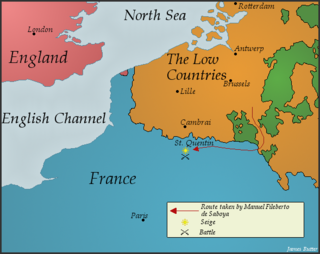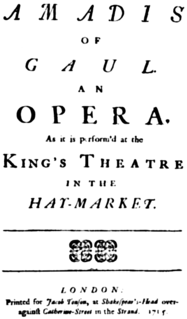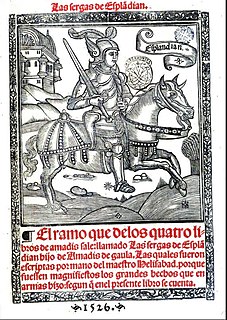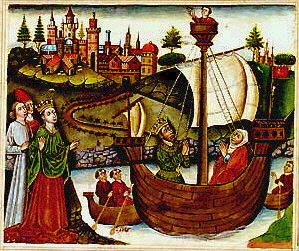Related Research Articles

Year 1557 (MDLVII) was a common year starting on Friday of the Julian calendar.

Amadís de Gaula ; Portuguese: Amadis de Gaula, [ɐmɐˈdiʒ dɨ gawlɐ]) is a landmark work among the chivalric romances which were in vogue in sixteenth-century Iberian Peninsula, although its first version, much revised before printing, was written at the onset of the 14th century.
This article contains information about the literary events and publications of 1557.
This article contains information about the literary events and publications of 1540.
Francisco de Moraes Cabral, also spelled Francisco de Morais Cabral, was a Portuguese writer. Born in Bragança, he served as personal secretary to the Portuguese ambassador in France, and composed, during two voyages to Paris, a chivalric romance called Palmerin d'Angleterre, a "spin-off" of the popular Amadís de Gaula series.

Henry of Castile, called the Senator, was a Castilian infante, the fourth son of Ferdinand III of Castile by his first wife, Beatrice of Swabia.
Feliciano de Silva was a Spanish writer. de Silva was born in Ciudad Rodrigo to a powerful family, Silva wrote “sequels” to La Celestina and Amadis de Gaula. de Silva was a prolific writer. His first chivalresque work, Lisurate de Grecia, was published in 1514. It is a relatively short work. His Amadis of Greece (1530) continued the success enjoyed by this first work. Amadis of Greece is divided into two parts which deal with the adventures of Amadis of Greece, Knight of the Burning Sword, son of Lisuarte of Greece and Onoloria of Trabizond (Trapisonda), as well as his love for both Princess Lucela of France and Princess Niquea of Thebes, whom he subsequently marries.
French Renaissance literature is, for the purpose of this article, literature written in French from the French invasion of Italy in 1494 to 1600, or roughly the period from the reign of Charles VIII of France to the ascension of Henry IV of France to the throne. The reigns of Francis I and his son Henry II are generally considered the apex of the French Renaissance. After Henry II's unfortunate death in a joust, the country was ruled by his widow Catherine de' Medici and her sons Francis II, Charles IX and Henry III, and although the Renaissance continued to flourish, the French Wars of Religion between Huguenots and Catholics ravaged the country.

Bernardo Tasso, born in the Republic of Venice, was an Italian courtier and poet.

François de Belleforest was a prolific French author, poet and translator of the Renaissance.

Amadigi di Gaula is a "magic" opera in three acts, with music by George Frideric Handel. It was the fifth Italian opera that Handel wrote for an English theatre and the second he wrote for Richard Boyle, 3rd Earl of Burlington in 1715. The opera about a damsel in distress is based on Amadis de Grèce, a French tragédie-lyrique by André Cardinal Destouches and Antoine Houdar de la Motte. Amadigi was written for a small cast, employing four high voices. Handel made prominent use of wind instruments, so the score is unusually colorful, comparable to his Water Music.
Nicolas de Montreux was a French nobleman, novelist, poet, translator and dramatist.

Amadis is an opera in three acts with prologue by Jules Massenet to a French libretto by Jules Claretie based on the Spanish knight-errantry romance Amadis de Gaula, originally of Portuguese origin, by Garci Rodríguez de Montalvo.

Las Sergas de Esplandián is a novel written by Garci Rodríguez de Montalvo in the late fifteenth or early sixteenth century. The novel is a sequel to a popular fifteenth century set of chivalric romance novels, Amadís de Gaula. While the novel itself has met with some criticism for its lack of literary style, it achieved particular notability in 1862, when Edward Everett Hale concluded that the novel was the origin of the name California.

Amadis or Amadis de Gaule is a tragédie en musique in a prologue and five acts by Jean-Baptiste Lully to a libretto by Philippe Quinault based on Nicolas Herberay des Essarts' adaptation of Garci Rodríguez de Montalvo's Amadis de Gaula. It was premiered by the Paris Opera at the Théâtre du Palais-Royal sometime from January 15 to 18, 1684. There was a later production at Versailles without scenery or machines in 1685.

Amadis de Gaule, or Amadis des Gaules, is a French opera in three acts by the German composer Johann Christian Bach. The libretto is a revision by Alphonse de Vismes of Amadis by Philippe Quinault, originally set by Jean-Baptiste Lully in 1684, which in turn, was based on the knight-errantry romance Amadis de Gaula (1508). Bach's opera was first performed at the Académie Royale de Musique, Paris, on 14 December 1779. It followed the contemporary French fashion for resetting libretti by Quinault. The work was not a success with the Parisian public, mainly because it pleased neither the supporters of Gluck nor those of Piccinni, the two leading rival opera composers in France at the time. It was the last opera J. C. Bach composed.

Jean Cassou was a French writer, art critic, poet, member of the French Resistance during World War II and the first Director of the Musée national d'Art moderne in Paris.

The Book of the Knight Zifar is the earliest fictional adventure tale in prose in the Spanish language. It was written around 1300, probably by a cleric of Toledo, Ferrand Martínez, who is mentioned in the prologue. The book has much affinity with contemporary works of chivalric romance.

Amadis de Grèce is an opera by the French composer André Cardinal Destouches, first performed at the Académie Royale de Musique on 26 March 1699. It takes the form of a tragédie en musique in a prologue and five acts. The libretto, by Antoine Houdar de La Motte, is based on the medieval romance Amadis de Gaula. La Motte's text was adapted to produce the Italian-language libretto for Handel's opera seriaAmadigi di Gaula (1715).
Sue Burke is an American writer and translator. She has written the science fiction novel Semiosis (2018) and its sequel, Interference (2019). Semiosis attracted favorable attention and acclaim and appeared on numerous lists of the best books of 2018.
References
- 1 2 3 4 One or more of the preceding sentences incorporates text from a publication now in the public domain : Chisholm, Hugh, ed. (1911). "Herberay des Essarts, Nicolas de". Encyclopædia Britannica . 13 (11th ed.). Cambridge University Press. p. 338.